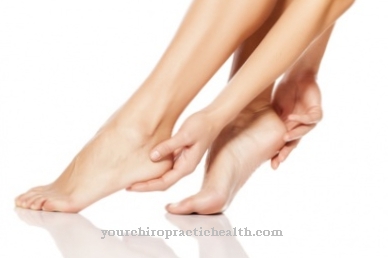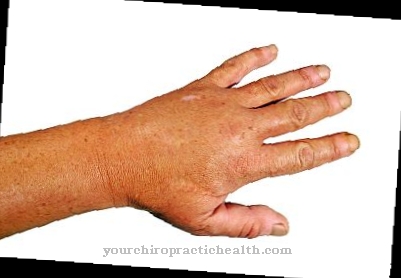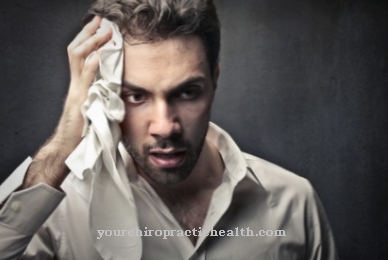A Coordination disorder summarizes all disorders that prevent a person from correctly executing the movements of his body.
What are coordination disorders?

Coordination literally means regulating something. The body regulates its functions through coordination so that it can be used meaningfully depending on the situation. When physical coordination is impaired, there are reasons that can be addressed and, in some cases, corrected.
If there is such a disorder of coordination, the result is a difficult to control and no longer orderly sequence of movements, which is usually an interplay of several incorrectly functioning muscle groups.
This condition is known as ataxia. The coordination of individual muscle groups can also be disturbed. As a subgroup of ataxia, one speaks in this case of asynergy. There are disorders of essential and non-essential coordination.
causes
Basically, a person learns his coordination in childhood. Examples of learned coordination would be learning to walk or using hands. Likewise, coordination is learned through training and habit. Both learning processes must take place in the same way in order not to block the execution of certain movements.
One physical cause of a coordination disorder can be damage to the nervous system. In the cerebrum, both sides of the body are controlled by the left and right hemispheres. Both halves of the brain are connected by nerve cords. Most of the time, both halves of the body are used at the same time. It is, for example, due to malnutrition, that one of the two hemispheres of the brain remained underdeveloped in childhood. This has a corresponding effect on the coordination of the body.
If there is damage to the cerebellum, automatic actions such as eating or keeping the body upright can no longer be carried out. If the brain is injured in an accident, the commands from the brain to certain muscle groups may no longer be received. Medicines and drugs can damage the nerve conductivity by blocking the switching points on the neurotransmitters.
You can find your medication here
➔ Medicines against concentration disordersDiseases with this symptom
- Early summer meningoencephalitis (TBE)
- Wernicke encephalopathy
- Zika virus infection
- Neuroborreliosis
- Restless legs syndrome (restless legs)
- Lyme disease
Diagnosis & course
In medicine, coordination disorders are referred to as dystonia. Focal dystonia refers to the disruption of individual muscle groups, while general dystonia refers to the disruption of several muscle groups.
Typical diagnoses of dystonia are eyelid cramp, spasmodic torticollis, dsytonic voice disorder and writer's cramp. Responsive dystonia, in which the legs are initially misaligned, is also typical.
Responsive dystonia is often incorrectly diagnosed as an orthopedic disease. Since a coordination disorder affects the whole body in many cases, it can manifest itself in a wide variety of ways and is often difficult to diagnose. In addition to problems urinating, muscle cramps, shortness of breath or chest pain, to name just a few symptoms, a sick person often feels over-stimulated, exhausted, suffers from headaches and dizziness.
A clear diagnosis is usually only made in milder cases and in the case of disturbances that are temporary. Many medical professionals speak of a "diagnosis of embarrassment" because of the many different symptoms and the difficulty of describing them precisely. This diagnosis is difficult to prove.
Complications
Coordination disorders lead to immense stress in everyday life. The movements cannot be made as they are thought and planned in the head. Particularly in the case of unconscious processes, this leads to a strong emotional and mental burden for the person concerned. Stress sets in, the nerves are strained and irritability is possible.
The general well-being is significantly reduced. In some cases there is a risk of occupational disability. The disturbances in coordination increase the risk of accidents. For some people, the stress leads to palpitations, high blood pressure and cardiovascular problems. People with incoordination are often viewed as mentally disturbed, alcoholics, or drug addicts. The feeling of isolation sets in and can trigger further mental disorders.
When the coordination disorders are treated, medication is often given. These have side effects, such as apathetic behavior, headache and stomach pain or loss of appetite. Relaxation procedures are performed that some people find uncomfortable.
If there is therapy that is initiated against the patient's will, the successes are very little or nonexistent. The patient himself often does not see the connection between a psychological problem and physical complaints.In addition, many sufferers are slow to achieve success. That leads to dissatisfaction.
When should you go to the doctor?
If the coordination disorders occur mainly after the consumption of alcohol or other drugs, a visit to the doctor is not necessary. The coordination disorders usually disappear on their own when the body has broken down the drug in question. However, a doctor should be consulted if drug use can no longer be stopped and it develops into an addiction.
If the coordination disorders occur only briefly and then go away on their own, a visit to the doctor is also not necessary. These can occur due to short-term symptoms or other influences and are usually harmless. Medical treatment is necessary if the disturbances in concentration persist and make life difficult for the patient. In many cases, physically demanding activities can no longer be carried out. If there are such severe restrictions, the coordination disorders must be treated by a doctor. Treatment is also necessary if headaches or nausea occur in addition to the coordination disorders.
As a rule, the family doctor is the first point of contact who recognizes the cause of the coordination disorders and then forwards the person concerned to a specialist.
Doctors & therapists in your area
Treatment & Therapy
A coordination disorder, which is based on a failure to learn certain movement sequences, is counteracted by physiotherapy. Changing your diet can help. If the disorder is drug-related, drugs are discontinued or replaced.
Care should be taken to ensure that those affected are spared psychologically. When treating a coordination disorder, it is particularly important not to treat physical symptoms in isolation, but also to treat the causes.
This is why drug therapies are used in combination with physiotherapy and psychotherapy, as well as relaxation methods. As a rule, it starts with relaxing, physical therapy.
If this does not help, the patient is usually referred to a psychotherapist. Care should be taken to ensure that the treatment is tailored to the individual patient.
Outlook & forecast
If the coordination disorders occur after the consumption of alcohol or other drugs, they are not a particular complication and go away by themselves when the drug has been completely broken down by the body. However, if the substances are taken over a long period of time, they can damage nerves, resulting in permanent coordination disorders.
The coordination disorders usually lead to heavy stress in the everyday life of the person concerned. Certain actions can no longer be carried out easily. This leads to stress and often psychological problems as well. Due to the coordination disorders, it is often not possible for those affected to go about their work. The symptom is also often accompanied by a racing heart, which in the worst case scenario can lead to a heart attack.
In most cases, treatment is provided by administering medication. In many cases, the patient must be admitted to a clinic to treat the incoordination. The further prospects with this symptom depend strongly on the patient's will to conquer the disease. In addition to treatment with medication, physiotherapy is often used, which usually increases the chances of success.
You can find your medication here
➔ Medicines against concentration disordersprevention
The only effective means of preventing coordination disorders is physical training. There are specially developed exercise courses that promote coordination and train the brain. However, doctors agree that targeted prevention of coordination disorders is almost impossible.
You can do that yourself
Coordination disorders can only be cured to a limited extent by the doctor and at home. As a rule, the further course of the disease depends very much on the cause of the coordination disorders. In most cases, coordination disorders can be combated with suitable physiotherapy. In addition to physiotherapy itself, the patient can also do certain sporting exercises at home and train their extremities. This training has a positive effect on coordination disorders and also prevents them. Especially in old age it is important to move around a lot and to train all parts of the body regularly.
A change in diet to healthy and low-fat food usually has a positive effect on healing coordination disorders. If the coordination disorders have arisen through the abuse of alcohol and drugs, the respective addiction must be combated. This can be done privately, with the help of a self-help group or in a special clinic. As a rule, the coordination disorders go away again when the addiction has been defeated.
Coordination disorders can be exacerbated by psychological stress. Hence, they should be avoided. These include, above all, bullying, marginalization and depression. In rare cases, coordination disorders are also inherited. Unfortunately there is no possibility for treatment or self-help.



























